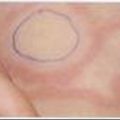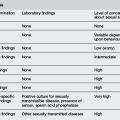22.3 Heat-induced illness
Introduction
In children, heat related illness is the second most common cause of non-traumatic death after heart disease.1 Children are particularly at risk because of the following:
Certain genetic disorders such as ectodermal dysplasia and Fabry’s disease also put children at risk of heat-related illness.3 In these conditions, there is an impaired ability to dissipate heat through sweating.
Causes of heat-related illness
Usually seen in setting of high ambient temperature and humidity. Examples are athletics, summertime sporting events and during heat waves. Young children left in cars are also particularly at risk. A review of 171 cases of heat related car deaths found that in approximately 25% of cases the child gained access to an unlocked vehicle and in 75% of cases, the child was left by an adult.4
 Increased heat production
Increased heat production
Clinical syndromes
The neonate/infant
Overheating is the most common cause in the neonate and infant. It is important to distinguish the healthy infant who is overheated from the febrile infant (Table 22.3.1).5
Mild overheating is usually not dangerous to infants though there may be some association with apnoeic episodes in premature babies.5 Hyperthermia from overheating, with sudden death,6 particularly in families with a history of malignant hyperthermia.
Babies with heat-related illness may present like any seriously ill infant. Hewson’s work has summarised this as A,B,C, fluids in and out approach.7
Heat cramps
Heat cramps occur in the setting of strenuous exercise in hot/humid conditions. A relative lack of body salt plays a part. Heat cramps can be very painful; however, most last for less than 1 minute. Abdominal muscle cramps have been known to simulate an acute abdomen.8
Heat exhaustion
Heat exhaustion in children presents as hyperpyrexia, vomiting, headache, lethargy and weakness with a normal mental state. The major problem is body water depletion; however, in some paediatric patients (e.g. cystic fibrosis where greater amounts of salt are lost in their sweat), heat exhaustion may occur predominantly due to salt depletion.8
Heat stroke
See Table 22.3.2 for comparison of signs and symptoms of heat-induced syndromes.
Other heat-related syndromes
Malignant hyperthermia (MH) is usually seen in the paediatric patient after general anaesthesia. 75% of victims have no family history and 20.9% have had a previous ‘normal’ anaesthetic.9 Mutations in the gene that programmes the ryanodine receptor, which is a tetrameric calcium release channel in the sarcoplasmic reticulum, are associated with malignant hyperthermia.10 This gene defect of the ryanodine receptor is present in 50% of cases. Approximately 18% of all cases of malignant hyperthermia occur in children, and their mortality rate is lower as compared to adults.11
The association between MH and skeletal abnormalities such as osteogenesis imperfecta is unclear.9
Serotonin syndrome, neuroleptic malignant syndrome (NMS) and anticholinergic syndrome: Serotonin syndrome is the clinical syndrome seen in the setting of excessive serotonin neurotransmission as a result of the ingestion of serotonergic agents. The triad of clinical features of the serotonin syndrome can be grouped under the headings of: central nervous system (CNS), autonomic and neuromuscular. NMS is a rare but potentially lethal syndrome, the exact aetiology of which is unclear. It is seen in children and adolescents taking antipsychotic medication. It has been suggested that the duration of NMS was one-third shorter in children taking atypical antipsychotics when compared with older, more typical agents.12 Methylphenidate (Ritalin) has been implicated in NMS. The anticholinergic syndrome is usually seen in the setting of deliberate self-poisoning with potent anticholinergic agents.13 Clinically there are both central and peripheral features. The latter are an extension of the physiological effects of blocking cholinergic receptors.
Drug-related: amphetamine use (e.g. ecstasy at rave parties) and other drugs (e.g. salicylates, anticholinergics) can cause heat-related emergencies in the adolescent group. Vigorous activity, high ambient temperatures and ingestion of amphetamine compounds contribute to the risk of hyperthermia at rave parties.14
Management
Malignant hyperthermia
The principles of treatment of malignant hyperthermia are similar to those of heat stroke. The antidote is dantrolene which inhibits the release of calcium into muscles. Several regimes have been suggested. Shann suggests an initial dose of 1 mg kg−1 min−1 until improvement, with a maximum dose of 10 mg kg−1 total.15 Another regime suggests giving 2.5 mg kg−1 intravenously and repeating every 10 minutes to a maximum of 10 mg kg−1.9 If the MH has been caused by an inhalational anaesthetic, the agent should be stopped immediately. Other manoeuvres include hyperventilation with 100% oxygen, bicarbonate in fulminant cases (2–4 mEq kg−1), lidocaine to treat arrhythmias and aggressive cooling of the child.
Serotonin syndrome, NMS and anticholinergic syndrome
These conditions are rare in children. The serotonin syndrome is usually seen when drug combinations are used, whereas NMS is most commonly an idiosyncratic reaction to a single agent. In patients with the serotonin syndrome, most resolve within 24–48 hours with supportive management and stopping the serotonergic agent/s. In severe cases, attention to ABCs, continuous core temperature monitoring and titrated intravenous benzodiazepines are often necessary.13,16 Specific serotonin antagonists have also been used such as cyproheptadine (0.1 mg kg−1 per dose) or chlorpromazine (0.25–1.0 mg kg−1 per dose). In NMS, benzodiazepines are useful in mild cases. In more severe cases, bromocriptine and dantrolene may have a role. The treatment of the anticholinergic syndrome is similar. Physostigmine (0.02 mg kg−1 per dose up to a maximum of 0.1 mg kg−1) is a centrally acting acetylcholinesterase inhibitor. Its exact role is controversial, but one review has suggested that in confirmed cases of anticholinergic poisoning in children, physostigmine might be more effective than benzodiazepines.17
Prognosis and disposition
Prognosis in heat-related illness is related both to the absolute temperature level and the duration of the elevation.18 Persisting coma and multiorgan failure are poor prognostic signs. As prognosis correlates with duration of hyperthermia, immediate cooling is critical. The mortality rate for heat stroke is approximately 10% and malignant hyperthermia, 7%.
1 Behrma R.E., Kliegman R.M., Arvin A.M., et al. Nelson Textbook of Pediatrics. Philadelphia: W.B. Saunders Company, 1996;2106. editors.
2 Kristie L.E., Paulson J.A. Climate change and children. Pediatr Clin North Am. 2007;54:213-226.
3 Dann E.J., Berkman N. Chronic idiopathic anhydrosis- a rare cause of heat stroke. Postgrad Med J. 1992;68:750-752.
4 Guard A., Gallagher S. Heat related deaths to young children in parked cars: an analysis of 171 fatalities in the United States, 1995–2002. Inj Prev. 2005;11:33-37.
5 Robertson NRC. Temperature control and its disorders. In: Textbook of Neonatology. Edinburgh: Churchill Livingstone; p. 299 [chapter 12]
6 Denborough M.A., Galloway G.J., Hopkinson K.C. Malignant hyperpyrexia and sudden infant death. Lancet. 1982;11:1068-1069.
7 Hewson P., Oberklaid F. Recognition of serious illness in infants. Mod Med. 1994:89-96.
8 Thompson A. Environmental emergencies. In: Fleisher G.R., et al, editors. Synopsis of Pediatric Emergency Medicine. Baltimore: Williams & Wilkins; 1996:452-456.
9 Rosenberg H., Bramdom B.W., Nyamkhishig S., Fletcher J.E. Malignant hyperthermia and other pharmacogenetic disorders. In: Barash P.G., Cullen B.F., Stoelting R.K., editors. Clinical Anaesthesia Textbook. Baltimore: Lippincott Williams & Wilkins, 2001. [chapter 20]
10 Neuromuscular disorders. In Nelson Textbook of Pediatrics, 18th ed., Saunders Elsevier; 2007:2552.
11 Rosero E.B., Adesanya A.O., Timaran C.H., Joshi G.P. Trends and outcomes of malignant hyperthermia in the United States, 2000 to 2005. Anaesthesiology. 2009;110(1):89-94.
12 Neuhut R., Lindenmayer J.P., Silva R. Neuroleptic malignant syndrome in children and adolescents on atypical antipsychotic medication: a review. J Child Adolesc Psychopharmacol. 2009;19(4):415-422.
13 Murray L., Daly F., Little M., Cadogan M. Toxicology Handbook. Edinburgh: Churchill Livingstone Elsevier, 2007;47-65.
14 Rieder M.J. Some light from the heat: implications of rave parties for clinicians. Can Med Assoc J. 2000;162(13):1829-1830.
15 Shann F. Drug doses, 14th ed. Melbourne: Intensive Care Unit, Royal Children’s Hospital. 2008:22.
16 Gillman P. Successful treatment of serotonin syndrome with chlorpromazine. Med J Aust. 1996;165:345.
17 Frascogna N. Physostigmine: is there a role for this antidote in pediatric poisoning? Curr Opin Pediatr. 2007;19(2):201-205.
18 Rogers I.R., Williams A. Heat-related illness. In: Cameron P., Jelinek G., Kelly A.-M., Murray L., Heyworth J., editors. Textbook of Adult Emergency Medicine. Edinburgh: Churchill Livingstone; 2000:607-610.











